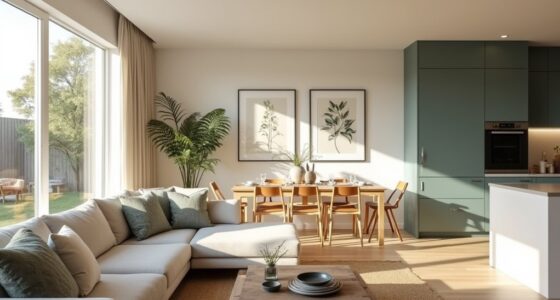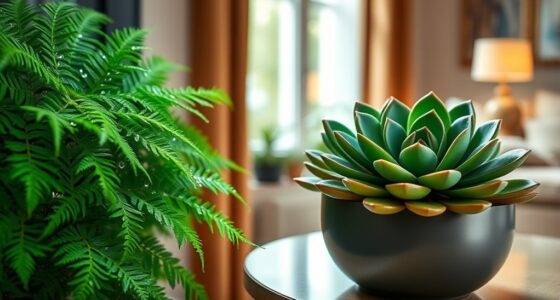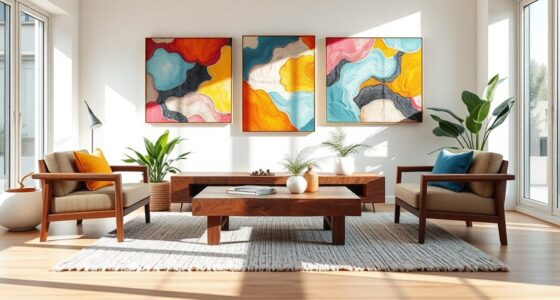Choosing and caring for low-light houseplants is simple and rewarding. Start by selecting varieties like Snake Plants, ZZ Plants, or Pothos that need minimal light and care. Assess your indoor lighting to find the best spots for your plants, ideally in north-facing rooms or other dim areas. Keep a consistent watering schedule, using well-draining soil, and address common challenges like overwatering. Want to learn about specific plant care tips? There’s much more to discover!
Key Takeaways
- Assess your indoor lighting by checking window orientation and observing daily light patterns to determine suitable low-light plants.
- Select low-light plants like Snake Plant, ZZ Plant, and Pothos, which thrive in dim conditions with minimal care.
- Ensure well-draining soil to prevent root rot; water every 1-3 weeks, allowing soil to dry out between waterings.
- Maintain humidity levels between 40-60% for optimal growth; consider location adjustments based on seasonal light changes.
- Regularly inspect plants for pests and yellowing leaves; prune and treat issues promptly to promote healthy growth.
Understanding Low-Light Plant Requirements
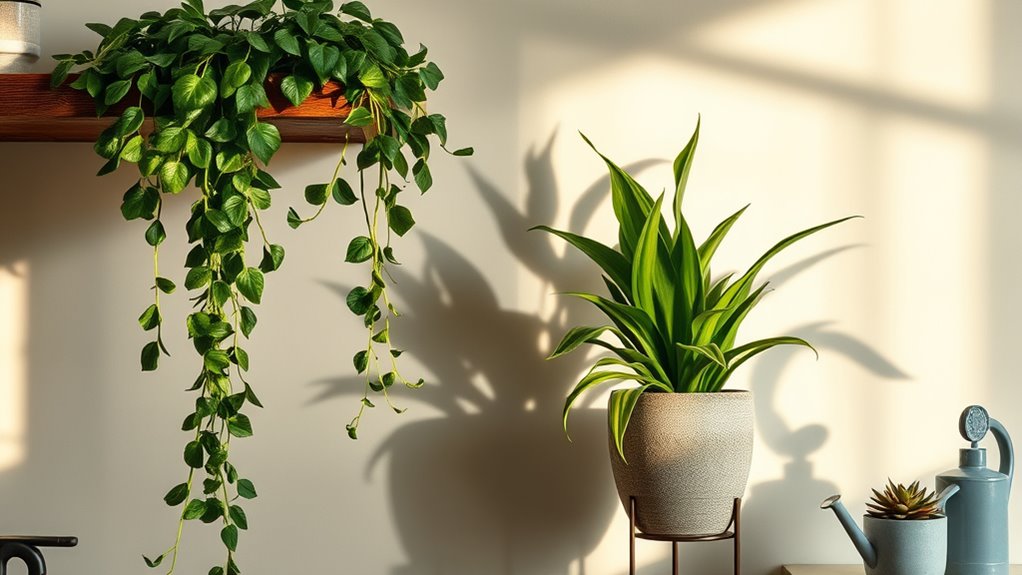
When you choose low-light houseplants, it’s essential to understand their specific needs to guarantee they thrive in your home. Low light plants, like Dracaena, ZZ Plant, and Snake Plant, can survive in dimly lit areas, often near north-facing windows. Additionally, many plants exhibit unique adaptations that allow them to thrive in lower light conditions. For instance, some plants have developed integrated pest management techniques to minimize pest issues even in low-light environments. Furthermore, selecting plants that are energy-efficient can enhance their ability to grow in low-light settings.
But remember, just because they can tolerate low-light conditions doesn’t mean they don’t need special care. Assess your space’s light levels before selecting your plants. Regular plant care is key; monitor your watering frequency, as low-light plants typically require less water—every 1-3 weeks.
Make sure you use well-draining soil to prevent root rot, a common issue in indoor gardening. Additionally, incorporating lighting design can enhance the overall health and aesthetic appeal of your indoor plants. By following these guidelines, you’ll create a healthy environment for your low-light plants to flourish.
Best Low-Light Houseplant Varieties

When it comes to low-light houseplants, you’ve got some fantastic options to choose from. Varieties like the Snake Plant, ZZ Plant, and Peace Lily not only thrive in indirect sunlight but also require minimal care. For instance, the Snake Plant is known for its air-purifying qualities, making it an excellent choice for improving indoor air quality. Additionally, these plants can enhance cognitive development by creating a more pleasant living environment. Decluttering your space to make room for these plants can further reduce stress levels, allowing you to fully enjoy their benefits. Let’s explore these popular picks and their unique care needs to help you find the perfect fit for your space. Additionally, incorporating native species into your indoor environment can enhance local biodiversity and promote healthier ecosystems.
Popular Low-Light Options
Low-light houseplants offer a revitalizing touch of greenery to your indoor space without demanding much attention.
If you’re looking for easy-to-care options, consider the Philodendron varieties like “Lemon Lime” and “Prince of Orange,” which thrive in low light conditions and need watering every 10 days to two weeks. Keeping your plants clean and dust-free can further enhance indoor air quality, allowing them to contribute even more to your environment. Incorporating whole foods into your diet, such as fruits and vegetables, can also complement the wellness benefits of maintaining houseplants. Additionally, research shows that certain plants can improve mood and reduce stress levels.
ZZ Plants are perfect for those who might forget to water, requiring only bi-weekly watering.
Snake Plants are another great choice, known for their air-purifying qualities and infrequent watering needs.
Pothos, including the Pothos Njoy, excels in low-light indoor plants, needing just weekly watering.
Finally, the resilient Spider Plant thrives in indirect sunlight and produces “baby” plants, making it ideal for beginners. These plants not only enhance your space but also align with the principles of wellness and intentional living, contributing to a healthier indoor environment.
Unique Care Requirements
While popular low-light options provide a great start, understanding the unique care requirements of specific varieties guarantees your houseplants thrive.
The Snake Plant and ZZ Plant are fantastic low-light house plants that need minimal care, requiring water every 2-3 weeks. Safety features in plant care routines can also ensure your plants stay healthy while minimizing risks. Additionally, investing in quality soil can further enhance your plant’s growth and resilience. It’s important to ensure that the soil has proper drainage to prevent root rot.
If you prefer vibrant foliage, consider the Philodendron “Prince of Orange,” which showcases beautiful leaves and needs watering every 10 days to two weeks.
Pothos, especially the “Njoy” variant, adapts well to low light, requiring water every 1-2 weeks and is perfect for hanging displays.
Finally, the Cast Iron Plant offers resilience in tough growing conditions, thriving in low light with minimal care, needing water every 1-2 weeks. Maintaining proper watering schedules is crucial to prevent overwatering and ensure your plants remain healthy.
Choose wisely, and your low-light indoor plant collection will flourish!
Assessing Your Indoor Lighting Conditions

To start evaluating your indoor lighting conditions, look around and identify where the light sources are coming from.
Pay attention to the orientation of your rooms, as this affects how much natural light each space receives. Additionally, consider how durable materials can influence the overall brightness and ambiance of your rooms. Understanding the impact of shared assets can also help you decide on the best placement for your plants to thrive in low-light conditions. In areas with limited sunlight, consider using art exhibitions to enhance the aesthetic appeal of your space, as they can provide inspiration for plant placement and decoration. Incorporating natural lighting into your assessment can further help you determine which plants will flourish best in your indoor environment.
Identify Light Sources
How well do you know the light conditions in your home?
Identifying light sources is key to successfully caring for low-light indoor plants. Here’s how to assess your space:
- Check Window Direction: North-facing rooms usually have the least light, making them perfect for low-light plants.
- Measure Light Intensity: Use a light meter or a smartphone app to find out where your home gets the best indirect light. Understanding your home’s environmental factors can help you select plants that thrive in low-light conditions.
- Observe Daily Patterns: Notice how light moves throughout the day. Areas receiving indirect sunlight for several hours are ideal for low-light plants. Additionally, understanding how soluble fiber impacts satiety can help you choose plants that complement your healthy lifestyle.
Evaluate Room Orientation
Which direction does your room face? Your room orientation markedly impacts the amount of natural light it receives. North-facing windows generally get the least light, making them perfect for low-light plants.
To guarantee your plants thrive, measure the indirect sunlight your space receives throughout the day. You might even consider using a light meter for a precise reading of light levels in different areas.
Keep in mind that seasonal changes can affect light availability, especially during the shorter winter days, which may require you to adjust plant placements or add supplemental lighting.
Also, don’t forget to account for obstructions like nearby buildings or trees that can limit the natural light available to your indoor plants.
Matching Plants to Your Lifestyle
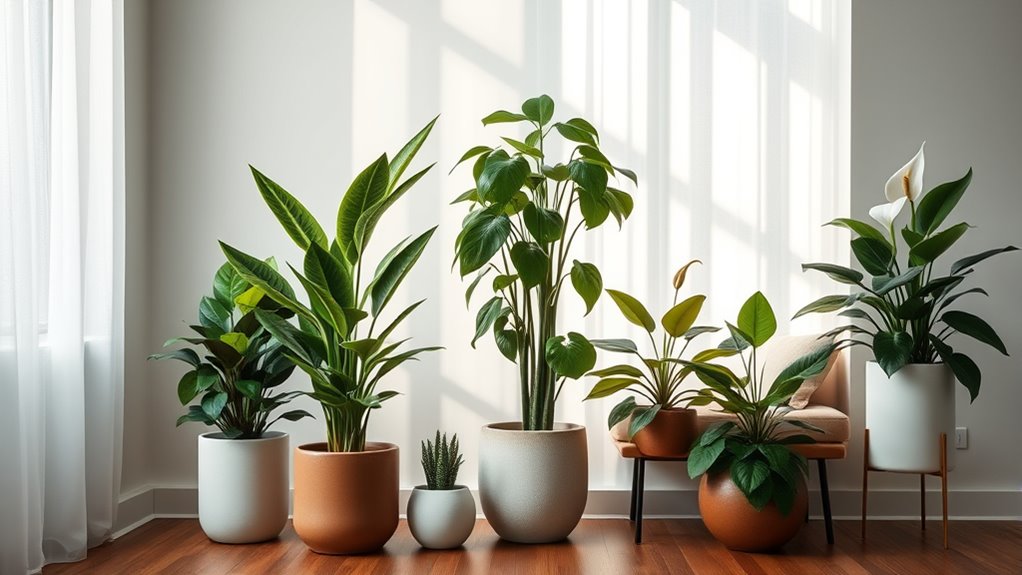
What factors should you consider when matching houseplants to your lifestyle? First, assess your daily routine and commitment level. For busy individuals, low-maintenance plants like the ZZ Plant and Snake Plant are perfect, requiring minimal care.
Next, think about your living space. Consider these options:
- Compact Plants: Pothos is great for smaller areas.
- Larger Varieties: Dracaena works well in spacious rooms.
- Pet Safety: Choose non-toxic plants like Spider Plant or Baby Rubber Plant if you have pets.
Finally, match your plants to your home’s aesthetic. Trailing varieties can enhance vertical spaces, while upright plants add structure.
With these factors in mind, you’ll create a harmonious indoor environment that suits your lifestyle.
Care and Maintenance Essentials for Low-Light Plants

While low-light plants are often forgiving, proper care and maintenance are essential to keep them thriving. Use well-draining soil to prevent root rot, allowing the soil to dry out between waterings—typically every 1-2 weeks. Monitor temperature and humidity levels, aiming for 40-60% humidity. Regularly prune yellowing leaves to encourage growth and deter pests. Fertilize with a balanced, diluted fertilizer every 4-6 weeks during the growing season. Place your plants in areas with bright indirect light, and consider supplemental lighting in fall and winter if needed.
| Care Aspect | Recommended Action | Frequency |
|---|---|---|
| Watering | Allow soil to dry | Every 1-2 weeks |
| Pruning | Remove yellowing/dead leaves | As needed |
| Fertilizing | Use balanced diluted fertilizer | Every 4-6 weeks |
| Humidity | Maintain 40-60% humidity | Regular checks |
| Light | Bright indirect light | Adjust as needed |
Common Challenges and Troubleshooting Tips

Even though low-light houseplants are generally resilient, they come with their own set of challenges that can affect their health and growth.
Here are some common issues and tips to troubleshoot:
- Overwatering: Verify the soil dries out between waterings. Many low-light plants, like the Snake Plant, thrive on infrequent watering every 2-3 weeks to prevent root rot.
- Insufficient Light: If you notice slow growth, consider using indoor lamps to supplement natural light, especially for plants like Philodendron that prefer indirect light.
- Pest Infestations: Regularly inspect leaves for pests. Treat infestations promptly to maintain plant health.
Also, pay attention to humidity levels, as humidity-sensitive plants like Boston Ferns may need extra moisture.
Adjust your care accordingly!
Ideal Locations for Low-Light Plants
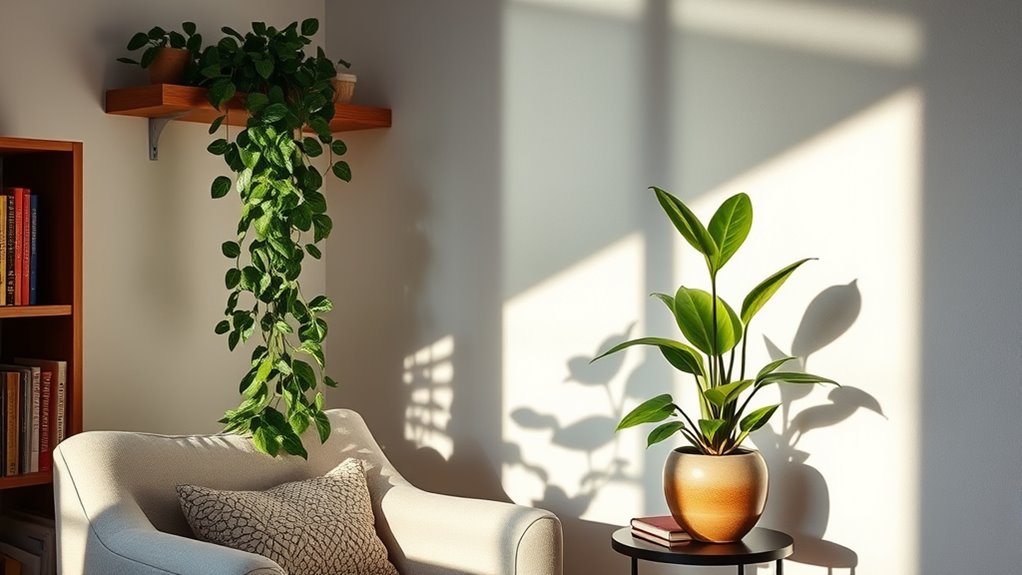
Finding the right spots for your low-light plants can enhance both their growth and your living space’s atmosphere.
Ideal locations include offices with fluorescent lighting, where natural sunlight is scarce. North-facing rooms are perfect for plants like Snake Plants and ZZ Plants, which thrive in minimal sunlight.
Dark corners of your home, such as shelves or side tables, can also benefit from low-light houseplants, adding greenery without direct sunlight.
Bathrooms, with their indirect light and higher humidity levels, are great for plants like English Ivy and Boston Fern.
Just remember to use well-draining pots and place your plants in areas with consistent temperature and humidity levels to prevent overwatering and guarantee healthy growth.
Enhancing Your Space With Low-Light Plants
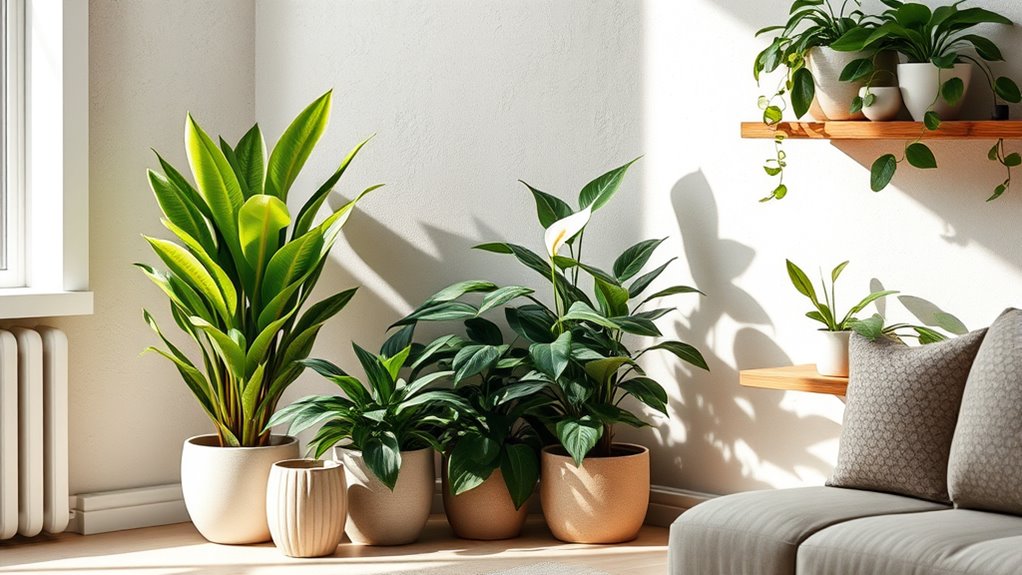
Low-light plants can transform your living space into a vibrant oasis, especially if you strategically place them in areas that need a touch of greenery.
Here are three ways to enhance your space with low-light houseplants:
- Choose Specific Plants: Incorporate air-purifying options like Peace Lilies or ZZ Plants to boost indoor air quality while adding style.
- Utilize Attractive Planters: Elevate their aesthetic appeal by using decorative pots or hanging baskets that complement your decor.
- Consider Growth Habits: Opt for trailing varieties for shelves and compact plants for small tables, balancing visual interest with available space.
Regularly rotating your low-light plants also helps maintain their health and maximizes their decorative potential in your home.
Frequently Asked Questions
What Houseplants Are Easy to Care for in Low Light?
If you’re looking for easy-care houseplants that thrive in low light, consider the Snake Plant or ZZ Plant. They’re resilient and require minimal attention.
Pothos, especially the Njoy variety, is forgiving and perfect for beginners. Philodendron varieties like Lemon Lime adapt well to various settings, while Spider Plants only need weekly watering.
With these options, you can enjoy greenery without the hassle of intensive care, making your space feel lively and fresh.
Where Is the Best Place to Put Low Light Plants?
The best place for low light plants is where they can receive indirect light.
North-facing windows are ideal, as are rooms like offices or basements with minimal sunlight. You can also enhance their environment by placing them on shelves or tables in darker corners.
Bathrooms work well too, especially those with higher humidity.
Just remember to avoid direct sunlight, as it can harm their leaves and stunt their growth.
What Is Considered Low Light for Indoor Plants?
Low light for indoor plants typically means areas that receive less than 100 foot-candles of light.
This includes spaces with indirect or filtered sunlight, like north-facing rooms or spots away from windows.
Remember, it doesn’t mean no light at all; plants can still thrive with minimal natural sunlight or even just artificial light.
Keep in mind that while some plants tolerate low light, they might still need occasional bright light to flourish.
Is Light Through a Window Considered Direct Sunlight for Plants?
Light that comes through a window isn’t always direct sunlight. It depends on how intense and unfiltered that light is.
If you’re just a few feet away from a south-facing window, you might get direct sunlight, but if there are sheer curtains or shading, it’s likely indirect.
For your plants, this means you need to evaluate their light needs and position them accordingly, especially if you’re working with low-light varieties.
Conclusion
In the dance of shadows and light, low-light houseplants can transform your space into a serene oasis. By selecting the right plants and nurturing them with care, you create a vibrant tapestry of life, even in dim corners. Embrace the beauty of these resilient greens, and let them thrive alongside you. With a little attention and the right placement, your home can blossom into a lush retreat, where every leaf whispers a story of growth and tranquility.


